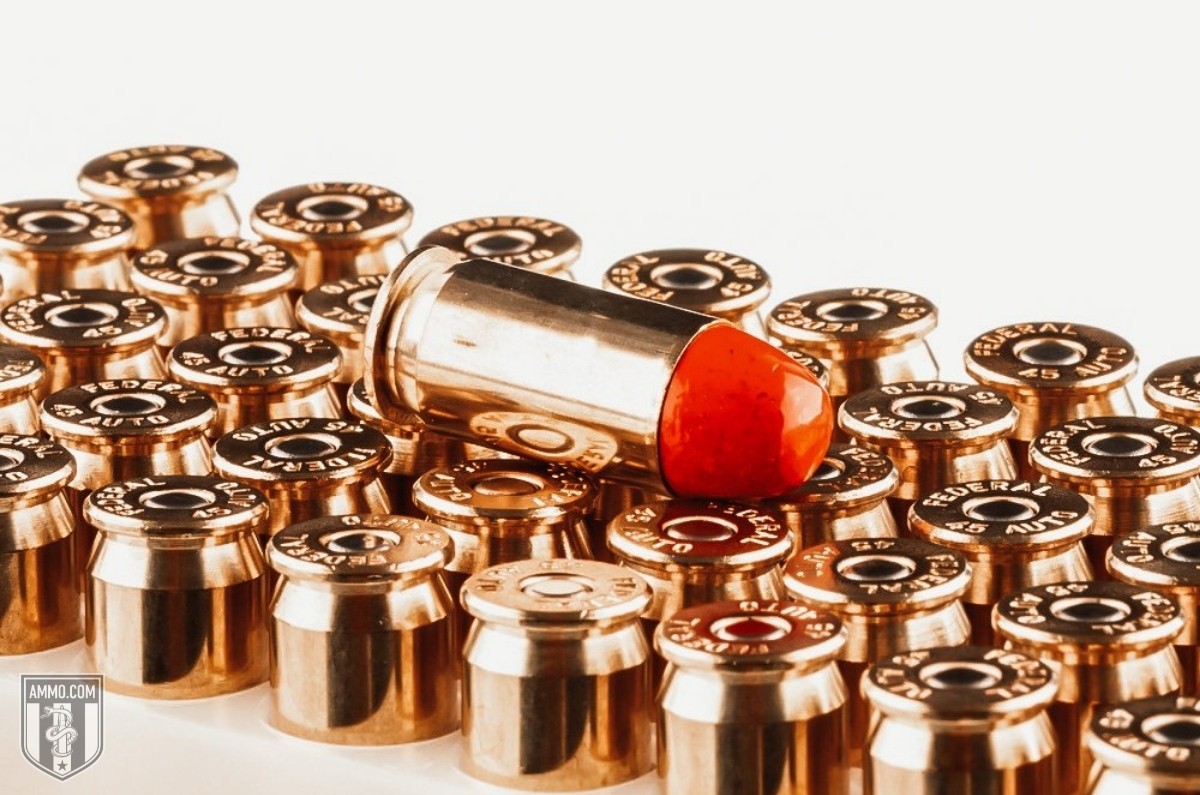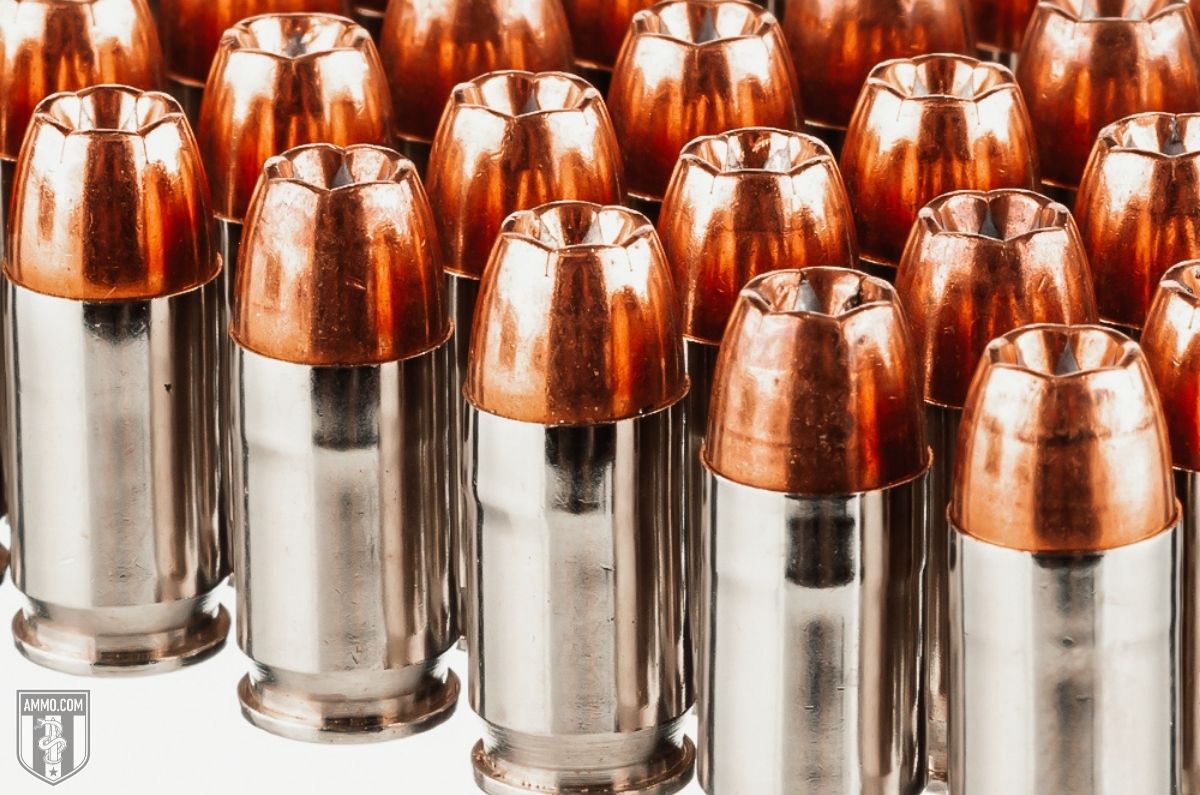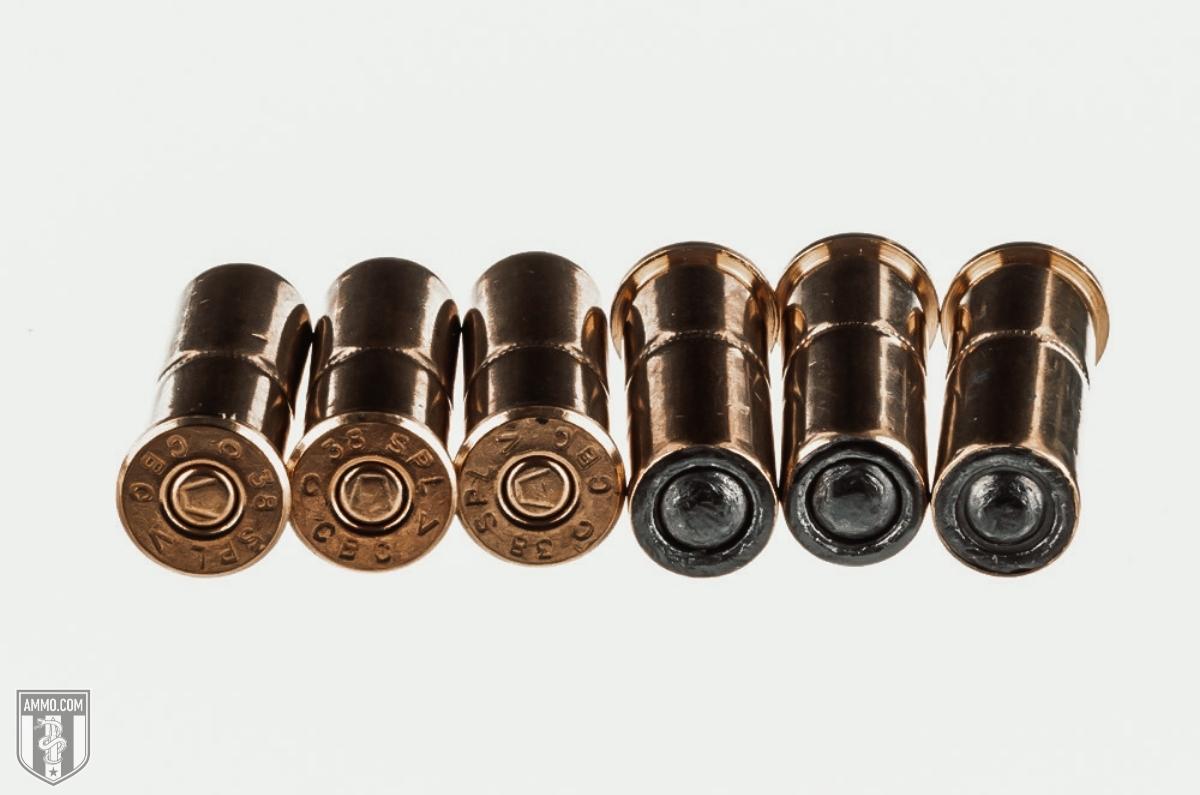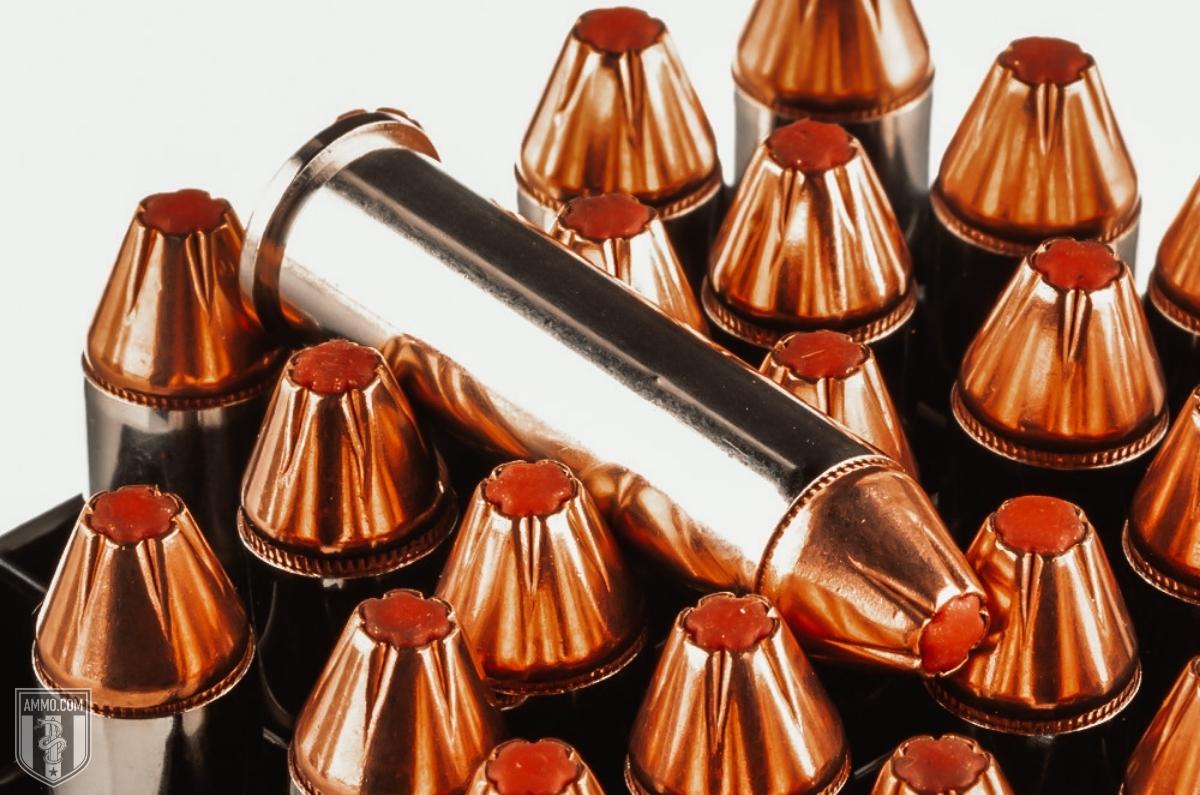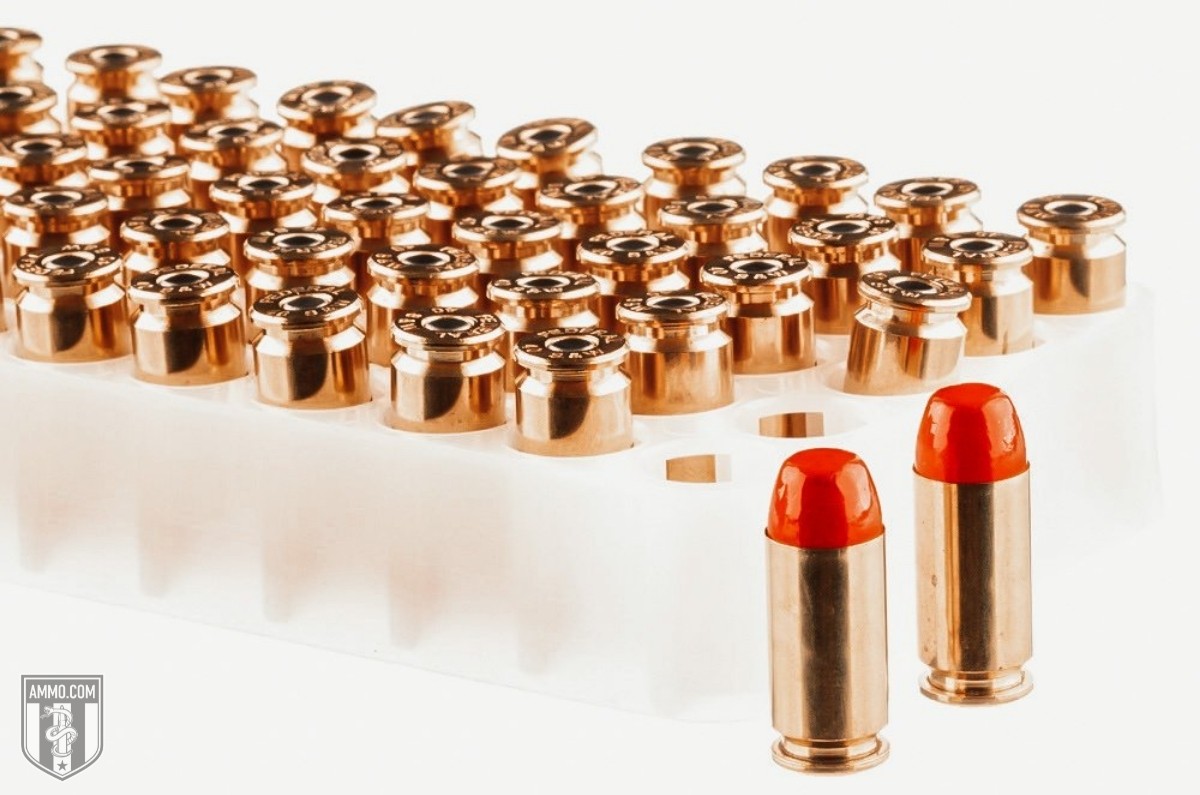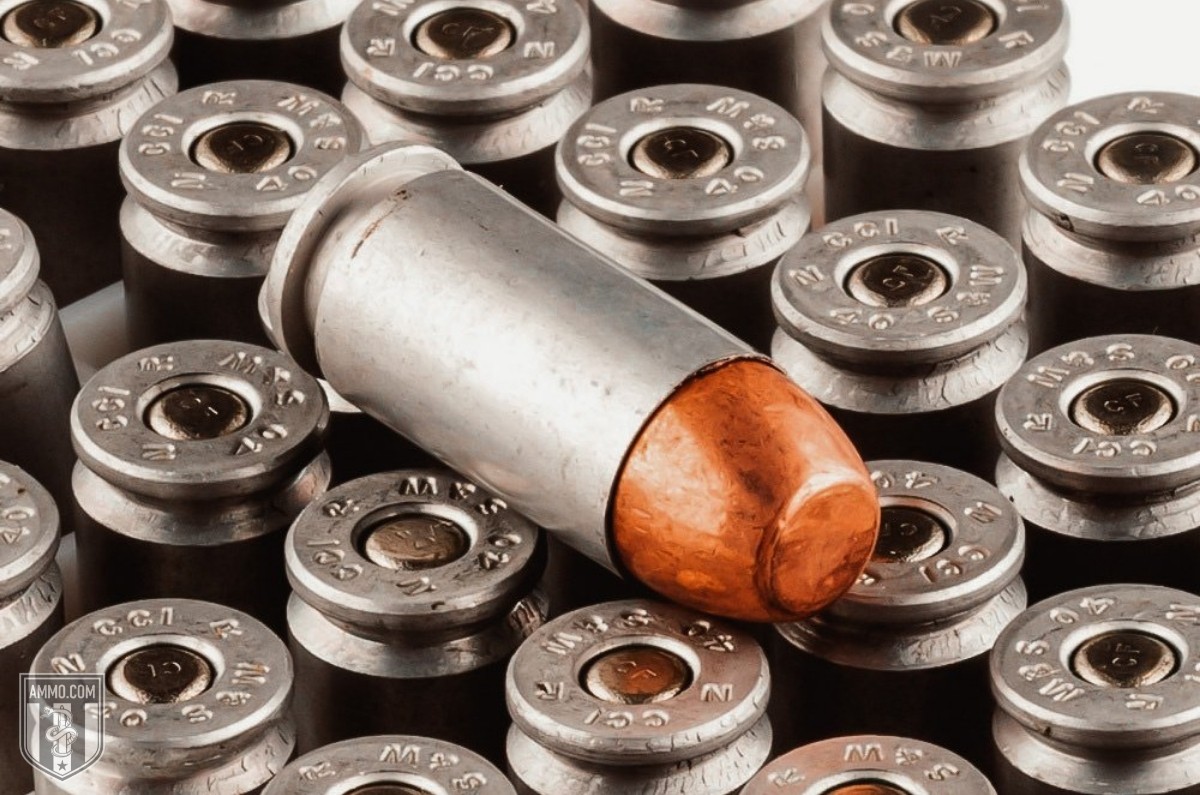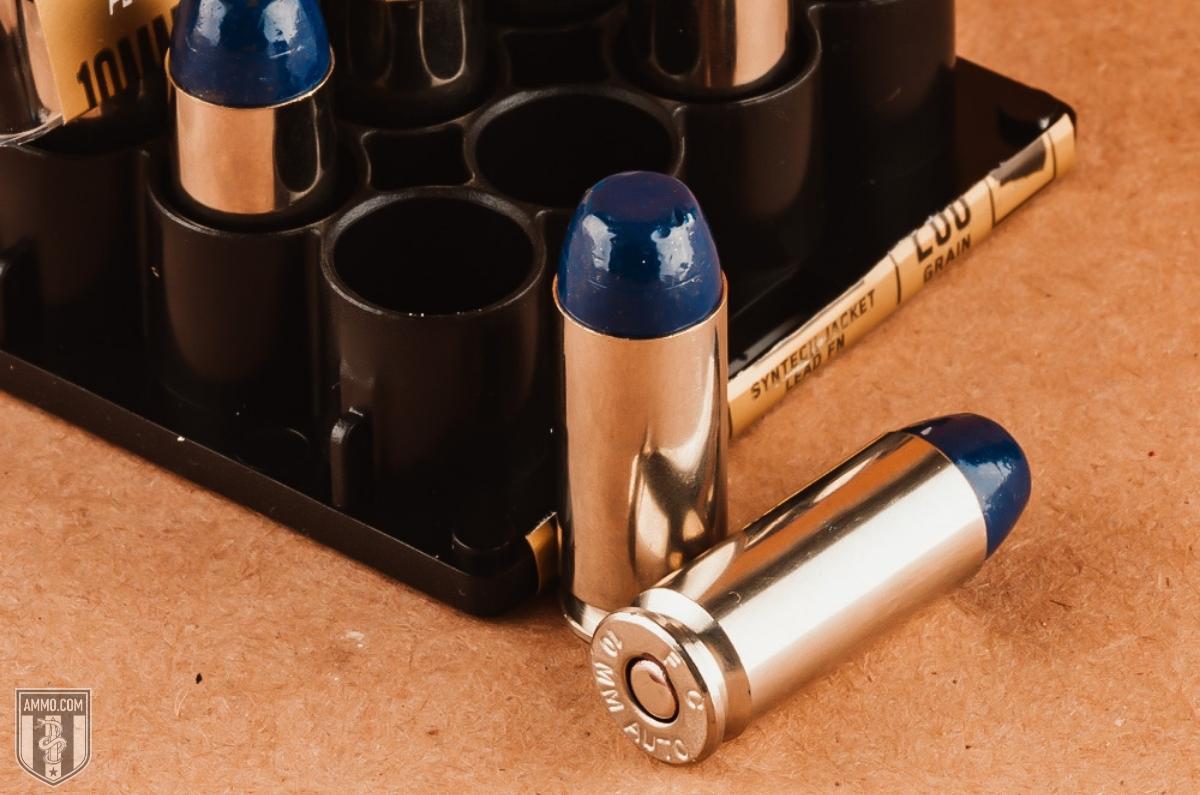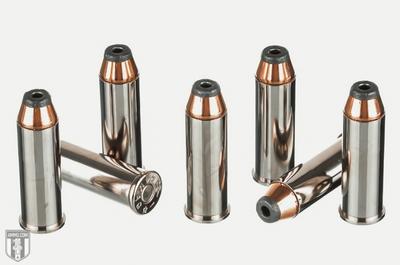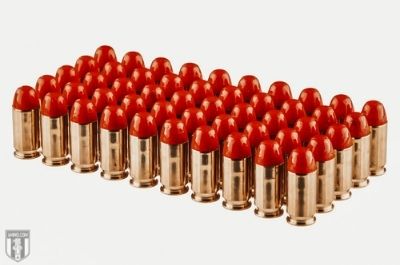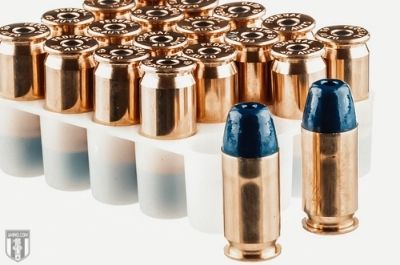Best Cartridge for Self-Defense: Protecting Yourself and Your Loved Ones
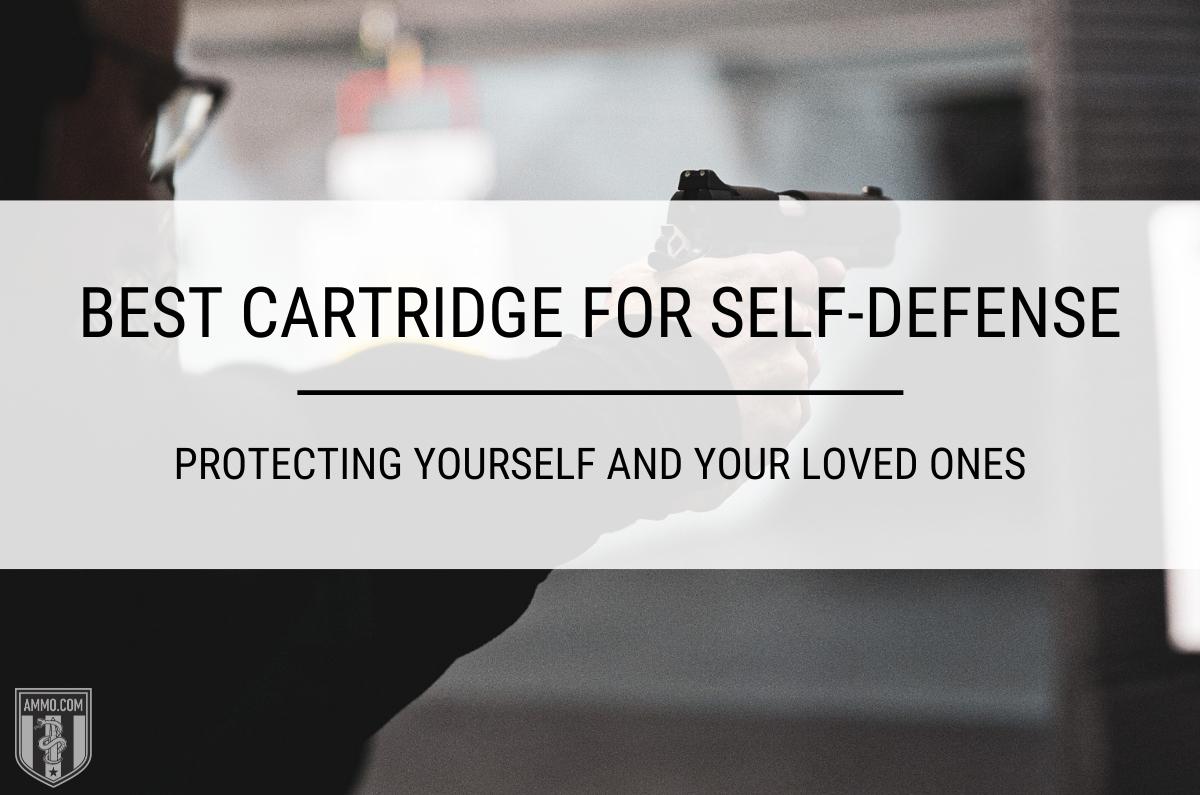
The debate over which pistol caliber is best for self-defense has been raging for decades (and by "caliber," we really mean "cartridge"). Gun owners are typically passionate about their choices, and the argument often turns ugly.
This article probably won’t put a stop to the “best cartridge for self-defense” bickering. However, by looking at the stats and data for the most popular defensive cartridges currently in production, we can help you make an informed decision about what will work best for you.
This article will also offer some sound science you can use when you find yourself embroiled in a hot dispute over your favorite self-defense cartridge.
Choosing the Best Caliber for Self-Defense
Deciding on a self-defense cartridge is a personal decision. There is no perfect one-size-fits-all best self-defense cartridge. What works well for one shooter might be an absolute nightmare for another.
To gain advantages in one area (like terminal energy), you’re going to need to make concessions in others (like recoil energy). Finding the right cartridge for your defensive needs is all about finding a balance between what you can shoot, what you can comfortably carry, and what has enough power to make short order of a dangerous threat.
Here is a list of the most popular options modern shooters use for defensive carry. Each has its pros and cons.
Looking at the data and using our personal experiences, we’re convinced that the 9mm Luger is the best all-around handgun cartridge for self-defense.
However, smaller shooters often find 9mm pistols difficult to fire – and even harder to conceal. We chose the 9mm because it works well for the vast majority of shooters in most defensive applications.
9mm Luger - Our Top Pick
The 9mm Luger (also called "9x19mm Parabellum," or simply "9mm") was once considered a subpar option for personal defense. Times have changed. Today, the 9mm is the most popular cartridge for both law enforcement and civilian concealed carry, and it earned that popularity fair and square.
Recoil
As Sir Isaac Newton so eloquently put it in his Third Law of Motion, “For every action, there is an equal and opposite reaction.”
In the world of shooting, the opposite reaction to firing a projectile is recoil. Recoil is the amount of “kick” a firearm produces when a bullet is fired. Guns that produce less recoil are generally easier to shoot.
Firearms with extreme recoil can be brutal to shoot, which causes issues with accuracy, especially on follow-up shots.
Compared to larger defense rounds, the 9mm produces relatively mild recoil. Because the 9mm’s recoil is easier to tame, shooters can make faster, more accurate follow-up shots. Since your life depends on good shot placement in a defensive shooting scenario, this is a major selling point for 9mm.
The subject of recoil isn’t always cut and dry. For example, a micro 9mm is more difficult to control than a full-size .45 ACP.
Power and Penetration
When it comes to “stopping power,” 9mm is very ammo specific. Modern advancements in ammo technology have brought the terminal performance of the 9mm up to par with much larger cartridges. Today’s 9mm ammo shoots faster, hits harder, and expands larger than the 9mm ammo we were firing just a decade ago.
When it comes to personal protection, some 9mm loads work better than others. For best results, choose expanding hollow points for your self-defense handgun.
Capacity
Although actual capacity varies by model, 9mm offers greater capacity than most other popular concealed carry cartridges. Because 9mm rounds are smaller than .40 S&W or .45 ACP, they don’t take up as much space in a magazine, which allows for greater round capacity.
Cost and Availability
9mm Luger ammo is pretty affordable compared to other popular pistol cartridges. That means you won’t need to drop a ton of cash on your carry ammo.
Because practice loads are relatively cheap, you can hone your skills without hurting your bank account. Since weapon proficiency is a necessary component of defensive shooting, this is another major perk for 9mm.
The 9mm is one of the most popular cartridges on the market today. There is no shortage of 9mm pistols or ammo to choose from. Every major manufacturer offers multiple gun models, with everything from autoloaders to revolvers, subcompact to full size. There are also hundreds of defense-specific loads for shooters to choose from.
.380 ACP
The .380 Automatic Colt Pistol (also called ".380 Auto" and ".380 ACP") was introduced in 1908. It was designed for the blowback pistols of the time. Compared to more modern pistol cartridges, the .380 ACP lacks power, speed, and terminal performance.
So why is it included on this list?
When you need it, a small gun chambered for .380 ACP is better than no gun at all.
We believe .380 Auto works better for a backup gun than it does a primary concealed carry weapon. Backup guns chambered for 380 are available in ultra-compact sizes, which makes concealing them a breeze.
Get a quality pocket or ankle holster, and a .380 ACP will make a great sidekick for your EDC sidearm.
Recoil
Although .380 ACP and 9mm Luger are loaded with the same caliber projectiles, .380 pushes lighter ones at slower speeds. While the .380 ACP may be lacking in velocity, those slower speeds do mean less recoil energy.
Recoil is influenced by many variables. One is gun weight. Heavier guns soak up more recoil than lighter ones. Although the .380 ACP produces less recoil energy than any of the other cartridges on this list, these cartridges run through tiny, lightweight pistols. Lightweight pistols don’t absorb much recoil energy, so most of it transfers to the shooter.
When shooting the tiniest .380 Auto micro pistols, you might feel more recoil than when you’re firing a compact 9mm. For example, a 95 grain projectile leaving the muzzle of a 0.6-pound .380 Auto pistol at 900 fps generates 5.4 foot-pounds of recoil energy. A 115-grain bullet traveling 1,150 fps from the barrel of a 1.5-pound 9mm pistol produces 5.2 foot-pounds of recoil energy. Not much difference.
Power and Penetration
The .380 Auto and the 9mm Luger use projectiles of the same diameter. However, the .380 ACP cartridge has an overall length of 0.984 inches and a SAAMI maximum pressure of 21,500 psi. In comparison, the 9mm measures 1.169 inches and has a maximum pressure of 35,000 psi.
The Federal Bureau of Investigation uses specific penetration test protocols to determine the effectiveness of defensive loads. According to FBI performance standards, a bullet should penetrate at least 12 inches into ballistics gel, but no more than 18 inches.
Meeting those protocols is difficult for .380 ACP when it loaded with expanding bullets, because a good portion of the energy needed for penetration is expended on terminal expansion instead. Penetration can also be much shallower if those bullets pass through heavy clothing first.
While non-expanding FMJs have an easier time reaching the magic 12-inch depth, the wounds they carve out aren't as wide. Since fractions of an inch matter when it comes to organ and artery damage, using a non-expanding bullet sacrifices terminal damage. Simply put: wide holes stop assailants faster than narrow ones.
Capacity
Tiny backup pistols don’t carry very muchammo. The subcompact Glock G42, which is chambered in .380 Auto, has a standard magazine capacity of only six rounds. Although you can purchase a 15-round magazine for it, it makes carrying the pistol much less practical.
Cost and Availability
Micro pistols designed for James Bond-style deep concealment are all the rage right now. That means there is a wide variety of .380 ACP pistols on the market.
Unfortunately, there isn’t nearly as much variety in the ammo department. Although most major manufacturers have several .380 ACP loads in their lineups, there isn’t nearly the selection that you’ll find for more popular loads like 9mm or .45 ACP.
The ammo you do find will cost you. Most .380 ACP loads are significantly more expensive than 9mm. Costwise, they are more on par with hefty hitters like .45 ACP.
.38 Special
If you’re a fan of wheel guns for self-defense, then .38 Smith & Wesson Special (more commonly known as simply .38 Special) is a great option. A revolver chambered in this mild-recoiling cartridge is capable of stopping bad guys. However, it does have its drawbacks.
Recoil
The .38 Special’s recoil is gentle, which is why this cartridge is often recommended to women and other recoil-sensitive shooters.
Load a snub nose revolver with .38 Special and the recoil gets a bit snappy. Although snubbies are easier to conceal, a medium-frame wheel gun is much easier to fire.
Power and Penetration
Although both 9mm and .38 Special fire the same caliber bullets, the .38 Special is a low-velocity cartridge. As such, it has a lot less oomph behind its projectiles.
The 9mm has a smaller case capacity (compared to the 38 Special: 13.3 vs. 23.4 grains H2O). This is because the .38 Special was originally designed to fire black powder. Black powder is less potent than the modern smokeless propellant the 9mm is designed for, which is why the 9mm can ignite a smaller propellant charge – and to greater effect.
To put the power difference in perspective, .38 Special has a SAAMI pressure specification of 17,000 psi (.38 Spl +P is higher at 18,500 psi). In contrast, 9mm (which is quickly becoming the gold standard for self-defense ammo) has a pressure ceiling of 35,000 psi.
A standard pressure .38 Special load launching a 125 grain bullet at a muzzle velocity of 900 fps generates 225 foot-pounds of muzzle energy. Meanwhile, a standard pressure 9mm load lobbing a nearly identical projectile achieves a muzzle velocity of 1,175 fps and 380 foot-pounds of muzzle energy.
While that is a significant difference of force in the 9mm’s favor, modern bullet designs have helped even the playing field for these two cartridges.
The .38 Special performs well in FBI penetration protocol tests. Although it doesn’t penetrate as deeply in ballistics gel as 9mm, that isn’t always a bad thing. Even when loaded with FMJs, .38 Special rarely over penetrates except at the closest defensive distances.
In scenarios where an innocent bystander could be behind the bad guy, a bullet that expands in soft tissue and stays there is a good thing.
Capacity
Most revolvers chambered in .38 special only hold five to six rounds, and wheel guns aren’t exactly easy to reload as semi-automatics.
While six rounds of .45 ACP might be enough to stop someone hellbent on violence, that many rounds could still be a stretch for .38 Special to achieve the same thing. Smaller caliber projectiles create smaller wound channels, so round count becomes that much more important.
Cost and Availability
Because Americans have a love affair with semi-automatic polymer-framed pistols like Glocks, SIGs, and Smith & Wesson M&Ps, many of them are designed and manufactured each year. Unfortunately, that means fewer revolvers are hitting gun stores. Even fewer revolvers chambered in .38 Special are rolling off assembly lines these days, so your options for a carry gun chambered in this mild-recoiling cartridge may be limited.
As fewer wheel guns chambered in .38 Special hit the market, ammo options also decline. Even cheap .38 Special ammo tends to run on the expensive side, especially compared to more popular options like 9mm. However, .38 Special is still more affordable than .45 ACP.
Buying in bulk is always a smart choice. That's why you should check out our stock of bulk 45 ACP ammo, or visit our bulk 38 Special Ammo page.
.357 Magnum
The .357 Magnum was easily the most popular handgun cartridge of the twentieth century. Introduced in the 1930s, the .357 Mag was designed as a high-velocity round to help law enforcement punch through the car doors and auto glass used as cover by Prohibition-era gangsters.
Although modern shooters have embraced newer cartridges designed for semi-automatic pistols, the .357 Magnum still has plenty to offer defensive shooters.
While .357 Magnum revolvers are generally too bulky and heavy for concealed carry, they make great sidearms.
Recoil
It’s safe to expect any cartridge with the word “Magnum” in its name to be a heavy kicker. However, on the spectrum of handgun recoil, the .357 Magnum sits somewhere in the middle.
Power and Penetration
The .357 Magnum has more velocity and delivers more energy both at the muzzle and on downrange targets than the 9mm.
The .357 Magnum is loaded with a *slightly* beefier bullet than the 9mm (0.357" vs. .355"). A wider bullet hitting with more force leads to more tissue damage and blood loss, both of which are necessary to quickly and effectively eliminate a threat.
Capacity
Because the .357 Mag is typically loaded into revolvers, shooters are usually limited to five or six shots.
Cost and Availability
All .357 Magnum revolvers can also safely run .38 special cartridges, which adds to their versatility. However, the selection of guns chambered for this magnum cartridge is generally limited to revolvers. (You can carry a 357 Mag Desert Eagle pistol if you want, but it is unwieldy!)
When it comes to price, both .357 Mag practice and defensive ammo cost significantly more than 9mm. There are plenty of different load options available to modern shooters, and you can always save a few bucks by buying in bulk.
.40 Smith & Wesson
Sitting between the popular 9mm and .45 ACP in terms of bullet diameter, the .40 Smith & Wesson (aka ".40 S&W" or ".40 vcal") is often called a “compromise cartridge.”
Introduced in 1990, the .40 S&W is a relative newcomer. The cartridge was specifically developed to match the performance of the FBI’s reduced-velocity 10mm Auto. Designers reduced the 10mm’s powder charge, removed the extra empty space, and shortened the case length to produce the new .40 S&W.
Recoil
The .40 S&W has a reputation for having snappy recoil and significant muzzle rise, both of which can be difficult for inexperienced shooters to tame.
Because the .40 S&W shoots a smaller projectile, it is easy to believe it should have less recoil than the larger .45 ACP. However, the numbers tell a different story.
A 155 grain bullet fired from the muzzle of a 1.5-pound .40 S&W pistol kicks with 10.6 foot-pounds of recoil energy. In comparison, a 2.5-pound .45 ACP pistol throwing a 185 grain projectile only produces 6.8 foot-pounds of recoil.
The heavier weight of the .45 ACP pistol certainly helps mitigate some of the recoil force. However, many shooters claim the .40 S&W’s recoil is harsh, snappy, and more difficult to control. The numbers certainly support that claim.
Power and Penetration
The .40 S&W fires the same projectiles as the 10mm Auto. Because the .40 S&W’s case holds 4.8 grains less powder than the 10mm, the cartridge fires projectiles at lower velocities and with less energy.
The faster, beefier 10mm sends 175-grain pills downrange at 1,160 fps with 523 foot-pounds of muzzle energy. The .40 S&W fires the same projectiles 150 fps slower, with "only" 396 foot-pounds of energy (which is still more than adequate for defense).
When we compare it to our favorite 9mm, the .40 has a clear energy advantage. The 9mm’s lighter projectiles leave the muzzle carrying only 339 foot-pounds of energy.
The widths of the average wound channels inflicted by the 9mm and .40 S&W are pretty similar. However, the .40 S&W's extra energy tends to drive its bullet deeper, as well as transfer more concussive force to soft tissue.
Capacity
While most .40 S&W handguns have capacities comparable to 9mm models, the .40 S&W models are typically heavier, bulkier, and more difficult to conceal.
Cost and Availability
In the not-so-distant past, the .40 S&W was incredibly popular with both law enforcement and civilian shooters. However, as the 9mm’s popularity has surged, the .40’s has waned. As a result, both handgun and ammo options are dwindling.
The waning popularity of .40 S&W has led to increased prices. Investing in bulk .40 S&W purchases can be a cost-effective strategy to maintain your shooting regimen and personal safety needs.
10mm Auto
Introduced in 1983, the 10mm Auto earned a ringing endorsement from defensive shooting guru Lieutenant Colonel Jeff Cooper. This powerful round was also favored by large government agencies, including the FBI.
Although the 10mm almost fell into obsolescence, modern shooters beginning to favor this cartridge all over again.
The 10mm is a powerful defensive load, and is also popular among handgun hunters. If you live in an area where local critters are known to attack, then the 10mm deserves your serious consideration.
Recoil
The main reason the FBI abandoned the 10mm Auto is that many of its agents were overpowered by the round's hard-hitting recoil. It was particularly difficult for them to make fast, accurate follow-up shots – a crucial skill in their line of work.
A 180 grain projectile fired from a 2.25-pound 10mm pistol kicks the shooter’s hand with 11.4 foot-pounds of recoil energy. That's significantly punchier than the other cartridges on our list (and even heftier than many .44 Magnum loads).
The recoil of the 10mm isn’t for the faint of heart. It certainly doesn’t make for a fun day of high-volume target shooting. Since it takes practice to develop proficiency, this is a major drawback for most shooters.
Power and Penetration
No one is going to argue that 10mm Auto isn't an absolute powerhouse. Indeed, critics often claim it's too powerful for self-defense.
The 10mm Auto sends a 175 grain projectile downrange at 1,160 fps with 523 foot-pounds of muzzle energy. It holds onto that energy fairly well: 437 foot-pounds at 50 yards. That makes this cartridge handy for stretching beyond typical defensive shooting distances.
Because of all that energy, the 10mm Auto often gets a bad rap for over-penetration, which can be a serious problem in crowded areas. The over-penetration issue can be improved by choosing loads designed for massive expansion such as Federal Personal Defense HST or Hornady Critical Duty.
Capacity
Standard size 10mm pistols generally have mag capacities on par with a standard size 9mm or .40 S&W. A standard 10mm pistol is slightly larger and heavier than a standard .40 S&W, but significantly bulkier than a standard 9mm.
The size and weight of 10mm pistols make them difficult to conceal. Subcompact models are much easier to conceal and more comfortable to carry. However, smaller 10mm pistols are significantly more difficult to control.
Cost and Availability
Because the 10mm Auto doesn’t have the same popularity it did in days gone by, there are fewer gun and ammo options available than there used to be. However, the 10mm is regaining much of its former popularity. If it continues on this trend, we should see more pistol and ammo offerings from manufacturers in the near future.
During the COVID-19 pandemic ammo panic, where you couldn’t sniff out a 9mm or .45 ACP round without the aid a bloodhound, most shooters could still get their hands on 10mm Auto. If you want a panic-resistant cartridge, 10mm Auto could be your go-to.
.44 Remington Magnum
The .44 Remington Magnum (also known as .44 Magnum or 10.9x33mmR) is definitely the most powerful cartridge on this list. The cartridge is almost synonymous with Dirty Harry’s double-action Smith & Wesson Model 29 revolver, which which is still known as “the most powerful handgun in the world” (even though it no longer is).
Since the .44 Magnum’s release, other more powerful cartridges have been developed. However, the .44 Magnum is still a heavy-duty, hard-hitting cartridge.
Recoil
This is a magnum cartridge. Magnum cartridges produce serious energy, and with serious energy comes serious recoil. Even strong, experienced shooters can have a hard time controlling the recoil from a .44 Magnum.
Power and Penetration
The .44 Magnum produces muzzle velocities around 1,500 fps, with hard-hitting muzzle energy near 1,000 foot-pounds. That energy is one reason this cartridge is preferred by handgun hunters pursuing big game.
All that power makes over-penetration a serious concern when using .44 Magnum for personal protection. However, if you live in bear country, your home defense weapon needs to have enough power to stop an angry bruin. In that case, that power becomes a major perk rather than a hindrance.
Capacity
Most .44 Magnum revolvers hold either five or six rounds.
Cost and Availability
Expect to invest some cash in a .44 caliber firearm. Although big bore revolvers are the most common .44 Magnum guns on the market, you can also find lever-action carbines chambered for this cartridge. The Desert Eagle semi-automatic is also available chambered for .44 Mag.
.45 ACP
The .45 Automatic Colt Pistol (also known as .45 ACP, or .45 Auto) has maintained constant fame since John Moses Browning introduced his iconic 1911 semi-auto pistol chambered for this cartridge.
The cartridge (and the 1911 pistol) are battle-tested options that helped America win both World Wars. Not only is this cartridge highly effective, but it is also one of the most reliable options on the market.
Recoil
The .45 Automatic Colt Pistol is a powerful cartridge. While that is good news for defensive carriers, that power and performance come at a price. These auto-loading pistols produce significantly more recoil than 9mm pistols.
Power and Penetration
The 9mm Luger’s power and performance have improved by leaps and bounds over the past several decades. Modern technology has helped the 9mm bridge the gap between it and the .45 ACP. That doesn’t mean .45 ACP doesn’t still have advantages over the 9mm, though.
The 9mm has improved in speed and power. However, there is one area where 9mm will never be able to catch .45 Auto: expansion.
Larger wounds cause more tissue trauma and blood loss than smaller ones. Right out of the barrel, the .45 ACP has almost a tenth of an inch more in diameter than the 9mm. If you’re shooting expanding hollow points, those .45-caliber projectiles can expand up to double their original diameter. That’s a lot of tissue trauma.
The .45 Auto lobs its bullets at relatively velocities. That isn't necessarily a bad thing, though. The .45 Auto's bullet is relatively heavy, which compensates for its triple-digit muzzle velocity. The average .45 Auto bullet weighs twice as much as a light 9mm load's.
The .45 ACP's muzzle velocity is subsonic by design. If have to fire your home defense firearm within the confines of your front hallway, your ears will thank you for choosing a suppressed 1911.
The .45 also has shallower penetration than most 9mm defense loads. Its slow-moving, bulky bullets often prevent pass-through shots, which is important if you need to neutralize a threat near innocent bystanders.
Capacity
Although capacity varies by model, the average magazine capacity for sub-compact firearms chambered in .45 ACP is only 10 rounds. Many companies offer extended magazines to increase capacity, which can be a serious advantage in a fight.
Cost and Availability
Gun owners benefit from a wide variety of .45 ACP ammo, as well as self-defense handguns chambered for this popular cartridge.
Buying .45 ACP ammo is going to cost more than purchasing 9mm rounds; up to twice as much per round in some cases.
Final Thoughts
The 9mm Luger loaded with a hollow point projectile offers a great balance of power, penetration, capacity, and concealability in an easy-to-shoot package.
While the .45 ACP fan club will probably send hate mail, we have to name the 9mm Luger the best cartridge for self-defense available to modern shooters. There’s a reason both local and federal law enforcement agencies are returning to 9mm duty weapons.
Cartridge Recommendations
- Best Caliber for Deer Hunting
- Best Big Game Caliber
- The 10 Best Coyote Cartridges
- Best Cartridge for Elk Hunting
- Best Cartridge for Self-Defense
- Best Cartridge for Concealed Carry
- Best Handgun Cartridge
- Best Moose Cartridges
- Best 40 S&W Ammo For Self Defense & Target Practice
- Best 223 Ammo
- Best .44 Magnum Ammo
- Best 270 Ammo for Hunting
- Best 17 HMR Ammo for Varmint Hunting and Plinking
- Best 22 Rimfire Ammo
- 4 Best AK-47 Ammo Picks [7.62x39]
- Best 38 Special Ammo for Self Defense
- Best Handgun Ammo for Self-Defense in Common Calibers
- Best 308 Ammo For Hunting & Target Shooting
- Best 300 Win Mag Ammo
- Best 243 Ammo for Target Shooting
- 10 Best 6.5 mm Cartridges For Long-Range Shooting and Hunting
- Best 45 ACP Hollow Points for Self-Defense
- Best 12 Gauge Ammo for Home Defense
- Best 32 ACP Ammo for Your Pocket Pistol or Backup Gun
- Top 13 Best AR Calibers That Aren’t 5.56 NATO
- Best Ammo for Smith and Wesson M&P 9mm Shield
- Best 7.62x39 Ammo for Self Defense
- Best 20 Gauge Ammo for Home Defense, Whitetail, and Upland Game
- Best Ammo for 1911 45 ACP
- Best 12 Gauge Ammo for Deer Hunting
- Best .40 S&W Ammo for Self Defense
- Best 7.62x39 Hunting Ammo
- Best 5.56 Ammo for Home Defense
- Best 380 Self-Defense Ammo
- Best 45 ACP Ammo for Every Situation
- Best Ammo for Glock 43x
- Top 5 Best 22 WMR Ammo on the Market
- Best Ammo for Glock 19
- Best Sniper Ammo
- Best 38 Special Ammo For Target Practice Precision Shooting
- Top 5 Best 45 ACP Ammo for Target Practice
- Best 6.5 Creedmoor Hunting Ammo
- Top 10 Best Sniper Rifle Cartridges
- Best 6.5 Grendel Ammo
- Best 5.45x39 Ammo for Your Gun
- Best 10mm Ammo for Bear Defense
- Best 350 Legend Ammo
- Top 5 Best 30-06 Ammo for Deer Hunting
- Best 30-06 Ammo for Accuracy
- Best 300 Win Mag Ammo for Deer
- Best M193 Ammo for Stockpiling
- Best 300 Blackout Ammo for a 7.5" Barrel
- Best Shotgun Shells for Target Practice
- Best 45 ACP for Bear Defense
- Best 223 for Deer Hunting
- Best Exotic 9mm Ammo
- Best Duck Hunting Shells
- Best .357 SIG Defensive Ammo
- Best Beretta APX 9mm Ammo
- Best 22 Pistol Ammo
- Best 9mm Ammo
- Best 308 Ammo for Deer Hunting
- Best Ammo for the Taurus GX4
- Best Ammo For Taurus PT111 G2
- Best Shells For Trap Shooting
- Best 38 Special Ammo for Snubbies
- Best 410 Ammo For A Taurus Judge
- Best Ammo for Ruger Security 9
- Best Ammo for Taurus G3c
- Best 7mm Rem Mag Ammo
- Best Lead-Free Hunting Ammunition
- Best 300 Blackout Ammo for Hog Hunting
- Best 9mm Home Defense Ammo
- Best 10mm Ammo for Every Shooting Situation
- Best .22 LR Ammo for Self-Defense
- Best Long-Range Hunting Bullets
- Best 357 Magnum Ammo For Every Shooting Situation
- Best 45 ACP Ammo For Self-Defense
- Best 6.5 Creedmoor Ammo For Accuracy
- Best 45-70 Ammo For Hunting & Target Shooting
- Best Turkey Loads
- Deadliest Shotgun Ammo For Home Defense
- Best 300 Win Mag Ammo For Elk Hunting
- Best 9mm Subsonic Ammo
- Best 7mm PRC Ammo
- Best 300 Blackout Subsonic Ammo
- Best 308 Subsonic Ammo for Hunting
